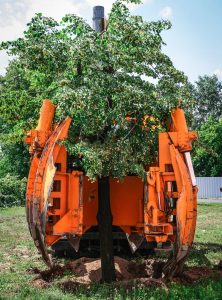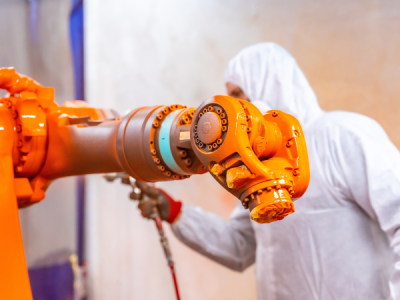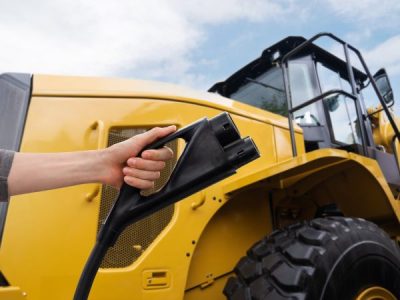Have you ever wondered how those fully grown trees are transplanted seamlessly into new locations? The secret is a machine called the tree spade. It’s a specialised machine and not as common as your standard tractor or dozer, but maybe you’ve seen its handiwork in parks, housing estates and shopping centres but never realised the engineering marvel behind it.
The tree spade is designed to swiftly remove trees from one spot and replant them in another with as little disruption as possible. With a skilled operator at the controls, the tree spade delicately relocates the tree to a new home, and it’s ready to continue growing as if nothing happened. Next time you see a mature tree in an unlikely spot, you’ll know it was the work of this mechanical marvel. The tree spade – who knew a machine could have such a green thumb?
What Is a Tree Spade Machine?
A tree spade machine is a powerful piece of equipment used to transplant mature trees. It acts as a giant shovel that can relocate an entire tree, including its root ball. This means trees that need to be removed can be relocated instead of chopped down. Best of all, it only takes seconds for the tree spade to harvest a complete tree.
An experienced tree spade operator controls the machine using hydraulic levers and pedals to operate a tree spade. First, the operator positions the spade around the base of the tree. Next, the operator activates the hydraulic system to force the spade into the ground around the tree. The spade’s blades then close around the tree, severing the roots and enclosing the root ball.
Once the tree is secured, the operator carefully transports the tree spade to the new planting site. The tree remains inside the spade during transport to minimise disturbance, but it can be transferred to another truck if long-distance travel is needed.
Upon arrival, the operator positions the spade over the new hole and lowers the tree into place. The operator then opens the spade to release the tree into the ground. Additional soil and amendments are then added around the exposed root ball to help the tree get established in its new home.
Using a tree spade allows mature trees to be moved efficiently while keeping their root systems largely intact. This gives relocated trees a much better chance of surviving and thriving after transplanting compared to traditional methods. While tree spades require a significant initial investment, for many nurseries and landscapers, the time and effort they save make them well worth the cost.
How Does the Tree Spade Work?
So how does this mighty machine work its magic? The tree spade essentially digs up and transports entire trees, roots and all.
- First, sharp blades are driven into the ground around the tree to cut the roots. Hydraulic rams then force the blades under the root ball, severing the roots from the surrounding soil.
- Next, the spade’s arms close around the tree, grasping it firmly so it can be lifted up and moved. The arms are adjustable to fit the size of the tree.
- Once the tree is secured, the spade is ready to transport it to its new home. An articulated arm lifts the tree up and swings it onto a flatbed truck. The tree remains in the grasp of the spade during transport to prevent damage to the roots.
- At the planting site, the spade lowers the tree into the planting hole and opens its arms to release the tree. The tree spade then pulls up and away, leaving the tree in its new spot, ready to be backfilled and watered.
Using a tree spade allows mature trees up to 100 years old to be transplanted with an excellent survival rate. While the initial cost may be high, a tree spade can move trees that would otherwise take many years to reach the desired size. For the right project, this mechanised marvel can be invaluable.

The Key Components of a Tree Spade
The key components of a tree spade work together to carefully extract trees from the ground, making them ready for transporting and replanting.
Hydraulic Arms
Hydraulic arms with sharp blades are inserted into the ground around the tree to cut the roots to a specified depth and diameter. The size and number of arms depend on the tree’s trunk size. Larger trees need more arms to provide stability during extraction and transport.
Backhoe
A backhoe is used to dig around the tree before the hydraulic arms are inserted. The backhoe loosens the soil around the roots to make it easier for the arms to reach the necessary depth. The backhoe also helps ensure the tree is extracted with an intact root ball by breaking up any dense soil.
Lifting Frame
The lifting frame supports the weight of the tree during extraction and transport. Cables from the hydraulic arms attach to the lifting frame, which a crane then hoists onto a flatbed truck. The frame keeps the tree stable and upright, preventing the root ball from crumbling or the tree from toppling over. Padding around the trunk protects the bark.
Truck Transport
A truck transports the tree spade and extracted tree to the new planting site. The flatbed provides a stable base for the lifting frame during transit. The tree is secured to the truck to prevent shifting that could damage the roots or loosen the soil in the root ball. The tree is kept upright for the duration of the short trip to the next location.
The key components of a tree spade, from the hydraulic arms and backhoe to the lifting frame and truck transport, all work synchronously to swiftly and efficiently move mature trees to new homes. With the help of these machines, trees can continue to thrive for generations in new locations.
Common Uses of Tree Spades in Australia
Tree spades are versatile machines used in Australia for a variety of purposes.
Transplanting mature trees
The most common use of tree spades is to dig up, and transplant mature trees carefully. Tree spades can move trees up to 100 feet tall with a trunk up to 3 feet in diameter. This allows landscapers and arborists to relocate established trees to new sites. Transplanting mature trees helps preserve the tree and avoids having to plant and wait for a new sapling to grow.
Salvaging trees from construction sites
Tree spades are often used when trees are in the way of new construction. Instead of cutting down the trees, tree spades can dig them up and move them to a new location. This helps save mature trees that would otherwise be destroyed. The trees get a second chance at life in a new home.
Installing pre-grown trees
Some tree farms and nurseries grow trees in open fields to maturity before selling them. Tree spades are used to dig up the pre-grown trees and instal them at the customer’s site. The trees can provide shade and ambience right away instead of having to wait years for a newly planted tree to become established.
In summary, tree spades have allowed for more trees to be preserved and relocated in Australia. They give trees a chance at a new home and allow people to enjoy more mature trees right from the start. The next time you see a large tree being moved down the road, you’ll know it’s likely travelling via a tree spade to its new destination.
FAQ: All About Tree Spades
What exactly is a tree spade?
A tree spade is a large machine that digs up and transplants mature trees. It has sharp blades that cut through roots to extract an intact root ball along with the tree. The root ball is then transported to a new location where the tree is replanted. Using a tree spade allows for transplanting trees up to 100 years old!
How does a tree spade work?
A tree spade has hydraulic arms with sharp blades that are inserted into the ground around the tree to cut through roots. As the arms close around the tree, the blades cut through roots and soil to form a root ball. The arms then lift the entire root ball out of the ground. The root ball, which can weigh up to 100,000 pounds, is moved using a crane onto a flatbed truck for transport to the new planting site.
What are the benefits of using a tree spade?
Tree spades provide several benefits:
- Transplant mature, established trees that would otherwise be difficult to move.
- Save time since large trees no longer need to be grown from small saplings.
- Higher survival rate for transplanted trees since the root ball is kept largely intact.
- It can be used to relocate trees that would otherwise be destroyed during construction or development. This helps preserve the urban tree canopy.
What types of trees can be transplanted using a tree spade?
Most tree species with a trunk diameter of 6 to 48 inches can be successfully transplanted using a tree spade, including:
- Deciduous trees: Frangipani, Flame bottle tree, Ash trees
Evergreen trees: Pine, Spruce, Fir, etc.
Ornamental trees: Crape Myrtle, Magnolia, etc.
Native trees: Eucalyptus, Paper Bark tree, Bottletree, etc.
Some tree characteristics that make a species a good candidate for tree spade transplanting include a centralised root ball, tolerance for root disturbance, and ability to recover from transplant shock. The tree spade has revolutionised tree transplantation and made it possible to relocate mature trees that would otherwise be difficult or impossible to move.
How Big of a Tree Can You Move With The Tree Spade
The tree spade is an impressive piece of machinery that can transplant mature trees up to 60 metres tall. Generally, the tree spade can lift any tree under 10” diameter. The weight of the tree is dependent on the total lift capacity of the machine the spade is attached to. Smaller trees will only require smaller machines, while bigger trees may need a machine with a higher lift capacity.
Spade Size
Tree spades typically range from 1 metre up to 6 metres in diameter. A spade around 3 to 4 metres can move most medium-sized trees up to 21 metres tall. For relocating really massive trees, spades 7 metres and larger are required. These supersized spades can move trees up to 30 metres tall but require very powerful trucks to haul and operate them.
The spade size also depends on the size of the root ball you want to extract. As a rule of thumb, for every 2-3 centimetres of trunk diameter, you need about 30cm of root ball diameter. So a tree with a 30-cm trunk would need at least a 3-metre root ball and spade. The bigger the root ball, the better chance the tree has to survive transplanting.
While the tree spade can move impressively large trees, the tree does experience a lot of stress. The bigger the tree, the more roots that are severed in the process. Be prepared to provide extensive aftercare for any transplanted tree, especially for the first few years after moving. With the right care and conditions, even the largest spade-moved trees can thrive in their new location. But not all trees survive, especially if the move is done improperly or the tree is in poor health to begin with.
When determining if a tree spade can move your tree, evaluate the size and condition of the tree as well as your ability to properly care for it after transplanting. If done right, the tree spade can give mature trees a new lease on life.
Protect Your Essential Equipment With APT Spray Painting
From civil construction to all-terrain agriculture, APT Spray Painting understands that every piece of equipment and machinery is diverse. Our spray painting solutions are versatile and follow a rigorous quality process. APT Spray Painting can facilitate anything from an ultra-fine, smooth-as-glass finish to extra-thick coats for ultimate protection from general wear and tear, as well as Australia’s extreme weather conditions. Check out our range of services or get in touch with us on (07) 3390 5721.




